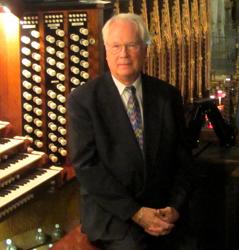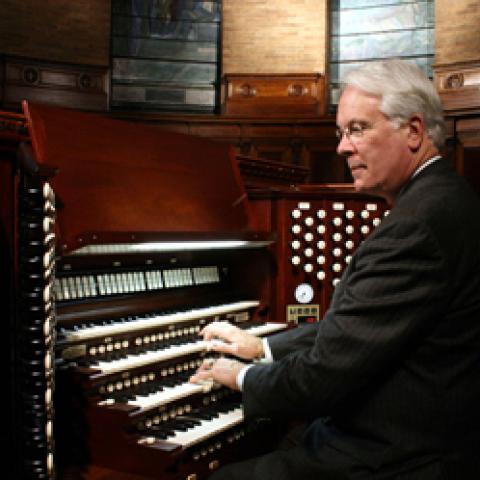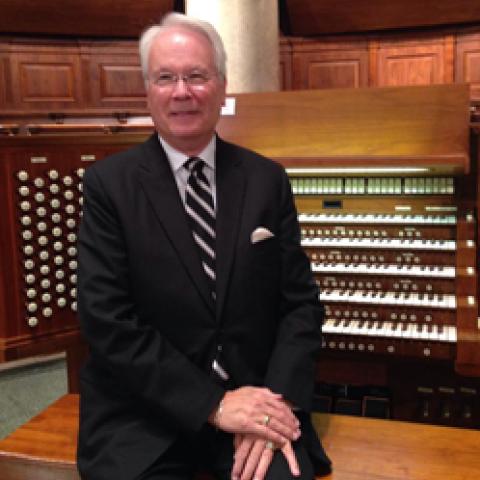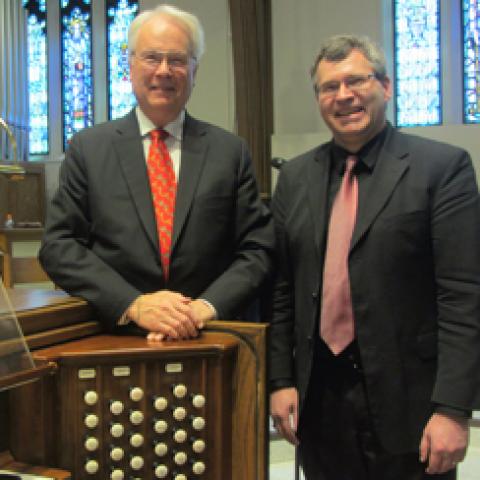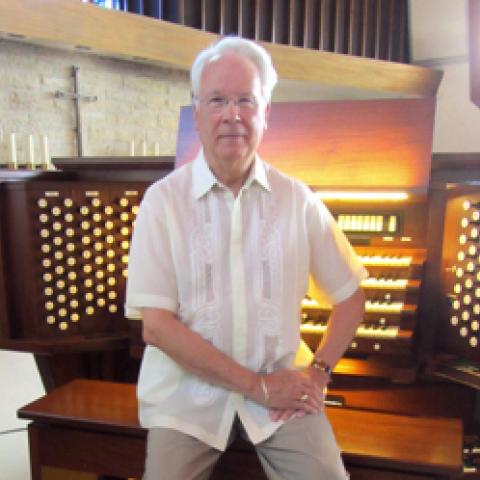Joel H. Kuznik
One advantage of retirement is having the luxury of hearing colleagues and ensembles here and abroad. Of course you don’t have to be retired, but the freedom to plan your own time helps. I have taken a number of European musical tours: Italian opera, Paris organs, Bach and Luther, and the Leipzig Bach Festival.
I have also taken two Holy Week-Easter pilgrimages. In the late 1990s I observed Holy Week in London and celebrated Easter in both the Western and Eastern Orthodox rites, first in Naples and then a week later in the Oia, Santorini, Greece. This year I decided to take my pilgrimage in London. These are the options I discovered on the Internet, and from which I made a spreadsheet for daily reference. Choices had to be made, and not everything made the list, such as “Götterdämmerung” at the Royal Opera House, which would have consumed one of my six days.
Maundy Thursday
13:10: Eucharist with music, St. Anne & St. Agnes, Bach chorales
17:00: Sung Eucharist, Westminster Abbey, Byrd Mass & Duruflé
18:00: Mass, Westminster Cathedral, Monteverdi & Duruflé
19:30: Mozart Requiem, St. Martin-in-the-Fields, New London Singers
Good Friday
11:15: Matins & Litany, Temple Church, Lotti & Tallis
14:30: Bach’s St. John Passion, St. John’s Smith Square, Academy of Ancient Music
15:00: Lord’s Passion, Westminster Cathedral, Bruckner, Victoria
Holy Saturday
15:00: Evensong, Westminster Abbey, Victoria
19:00: Easter Vigil, St. Paul’s, Langlais Messe Solennelle
20:30: Easter Vigil, Westminster Cathedral, Vierne Messe solennelle
Easter Sunday
10:15: Matins, St. Paul’s, Britten Festival Te Deum
10:30: Eucharist, Westminster Abbey, Langlais Messe Solennelle
16:00: Early & baroque music, Wigmore Hall, Florilegium, Bach & Telemann
16:45: Organ recital, Westminster Cathedral
18:00: Easter music & Eucharist, St. Anne & St. Agnes, Handel & Telemann
Monday
19:30: Handel’s Messiah, St. Martin-in-the-Fields, Belmont Ensemble
Maundy Thursday
A few blocks behind St. Paul’s Cathedral is St. Anne’s Lutheran Church, an international congregation founded in 1951, worshiping at the church of St. Anne and St. Agnes designed by Sir Christopher Wren after the Great Fire of London (1666) and consecrated in 1680. Built in the form of a Greek cross, this small church was bombed in WWII, but was restored and reconsecrated in 1966 as a Lutheran parish. In addition to its architectural history, famous residents of the parish have included John Milton, John Bunyan, and John Wesley.
St. Anne’s is known for its music, “particularly in the Lutheran tradition of J. S. Bach, Schütz, and Buxtehude.” There are over 100 performances a year, including lunchtime concerts on Monday and Fridays. The core musical group is the Sweelinck Ensemble, a professional quartet under the direction of Cantor Martin Knizia. The St. Anne’s Choir had recently sung Bach’s St. John Passion, and last December their Bach Advent Vespers was featured in a live broadcast on BBC Radio 3; .
Eucharist with Music
Chorale: O Mensch bereit das Herze dein, Melchior Franck
Chorale: Im Garten leidet Christus Not, Joachim a Burgk
Chorale: Durch dein Gefängnis, Gottes Sohn, J. S. Bach
Chorale: Jesu Kreuz, Leiden und Pein, Adam Gumpelzhaimer
Ehre sei dir Christe (Matthäus Passion), Heinrich Schütz
The chorales were interspersed throughout this service and were sung handsomely by the Sweelinck Ensemble accompanied by the cantor on a continuo organ. The concluding Schütz St. Matthew Passion was particularly stirring. Definitely worth a detour from the large churches to hear baroque music with this degree of authentic intimacy.
Westminster Abbey
Westminster Abbey, as glorious inside as it is dramatic outside, had a late afternoon Eucharist that moved the soul. So much can be said about the extraordinary history and presence of this church dating back to a Benedictine monastery in 960. It was later enlarged under King Edward the Confessor and consecrated in 1065 in honor of St. Peter, known as the “west minster” (Old English for monastery) in distinction from the east minster, St. Paul’s Cathedral. This magnificent gothic building is the result of work begun in the 13th century under Henry III and was not completed until 16th century.
Information, including details on the Harrison & Harrison organ (1937, four manuals, 78 stops), can be found at .
Sung Eucharist with the Washing of Feet
Mass for Four Voices, William Byrd
Organ prelude: Schmücke dich, o meine Seele, Bach
Improvisation leading to processional hymn: “Praise to the Holiest in the height” (Gerontius)
Gradual during Gospel procession: “Drop, drop, slow tears” (Song 46, Orlando Gibbons)
During the washing of the feet: Ubi caritas et amor, Maurice Duruflé
St. John 13:12–13, 15, plainsong mode II
Offertory hymn: “O thou, who at thy Eucharist didst pray” (Song 1, Orlando Gibbons)
After the Communion: Dominus Jesus in qua nocte tradebatur, Palestrina
While sacrament is carried to altar at St. Margaret’s: Pange lingua, plainsong mode II
During the stripping of the altar: Psalm 22:1–21, plainsong mode II
Westminster Abbey has an aura resonant with an awe of the divine. The service was without sermon, but so rich in ceremony and ritual that the preaching was in the actions, music, and language of the liturgy—in themselves a powerful message. Here everything seemed so right, from the dignified helpfulness of the ushers to the purposeful solemnity of the clergy—all enhanced by music done so well that it doesn’t call attention to itself because it is transparently integral to the worship and sung in a spirit reflective of the day’s liturgy. One did not just watch, but was drawn into the moment and left with an inner tranquility that spoke the essence of Maundy Thursday.
Good Friday
The weather was London: wet, dank, chilly and bleak—so fitting for the day. The Temple Church was recommended, not because of its recent attention due to the “The Da Vinci Code,” but primarily for its most traditional liturgy and excellence in music. The “Round Church” dates from 1185 and was the London headquarters of the Knights Templar. Their churches were “built to a circular design to remind them of the Church of the Holy Sepulchre at Jerusalem, a round, domed building raised over the site of the sepulchre where Jesus was buried.” The elongated choir was added by Henry III and consecrated on Ascension Day, 1240. The website provides an intriguing history of this unique church with directions and a much-needed map; .
Choral Matins, Book of Common Prayer (1662)
Introit: Crux fidelis, inter omnes, King John IV of Portugal
The Responses, plainsong
Venite, Exultemus, Anglican chant, Edward John Hopkins
Psalm 22, plainsong
The Lamentations of Jeremiah 1:1–2, Thomas Tallis
Benedictus, plainsong
Anthem: Crucifixus etiam pro nobis, Antonio Lotti
Litany, Thomas Tallis
Stephen Layton, director of music, directs a refined choir of men and boys, who were most telling in the Lotti Crucifixus, accompanied on a portative by the organist, James Vivian. The remainder of the service was played on the imposing and very British Romantic organ built by Harrison & Harrison (1924 and 2001, four manuals, 62 stops). The history of The Temple’s organs, including one by Father Smith, can be found on the website.
Back on Fleet Street I hopped on a bus to Westminster, hoping to hear Bach’s St. John Passion at St. John’s, Smith Square, just blocks from Westminster Abbey. A deconsecrated church dating from 1728, it now serves as a popular concert venue. In the crypt is a handy, economical restaurant “The Footstool,” where lunch was being served; .
St. John Passion, Johann Sebastian Bach, sung by Polyphony with the Academy of Ancient Music, Stephen Layton, conductor
Andrew Kennedy, Evangelist, tenor; James Rutherford, Christus; Thomas Guthrie, Pilatus; Emma Kirkby, soprano; James Bowman, countertenor; and Roderick Williams, bass.
This was a superb, masterful performance by a mature choir of 26 and professional soloists. The chorales were sung with care and the arias with sensitivity. The conductor’s tempos were quite sprightly and his approach dramatic, sometimes so much so that the next recitative intruded on the end of a chorale. This was, nevertheless, a fitting and most inspiring way to observe Good Friday.
Holy Saturday—Easter Eve
The Easter Vigil with its roots going back to earliest Christianity is the epitome of the Christian message and worship. It combines a rehearsal of salvation history with the rites of passage for the candidates (Latin, “those dressed in white”) through Baptism and Confirmation, and culminating in a celebration of the “Breaking of Bread” as Jesus did with his disciples after the Resurrection. The Vigil is an extended service with power-laden symbolism—the passage from utter darkness to brilliant light, the anointing with oil in the sign of the cross, the drowning of the self in baptismal waters, “putting on Christ,” and the sharing of the bread and wine in union with the community of faithful.
In London there could be no more fitting place to celebrate the Vigil than the regal diocesan St. Paul’s Cathedral, founded some 1500 years ago in 604 by Mellitus, a follower of St. Augustine who was sent to convert the Anglo-Saxons. It has been rebuilt a number of times with the most recent version begun in 1633 with a neo-classical portico or façade. The current design by Christopher Wren received royal approval in 1675, but was not finished until 1710. Later came the woodwork by Grinling Gibbons for the huge Quire and Great Organ, and in the 19th–20th century the glittering mosaics in the dome, envisioned by Wren. Most will remember St. Paul’s as the site of Prince Charles’s wedding to Diana. It has just undergone a complete renovation at a cost of £40 million in anticipation of its 300th anniversary in 2008; .
The organ was built by Henry Willis (1872) with an extensive renovation and enlargement completed by Mander (1977, five manuals, 108 stops). Not many organs deliver the overpowering experience that this organ can, especially when stops in the dome are added with a sound that not only surrounds, but also envelops worshippers.
The liturgy took place, not in the grand Quire, but “in the round” under the dome with a free-standing altar at one axis and the choir (with a small organ) to the left on risers, surrounded by the congregation.
Upon entry one received an impressive 28-page service booklet. One could only wonder “O Lord, how long?” But the service moved right along in two hours, including baptisms and confirmations. The service began in darkness; only with the procession to the dome by the participants did light begin to dawn as candles were shared. The Vigil had only one lesson instead of the usual nine readings. Then—the dramatic Easter Greeting by the bishop, “Alleluia! Christ is risen,” followed by bells and a thunderous fanfare from the organ—with a sudden blaze of almost blinding light as all the cathedral and the dome with its glittering mosaics lit up.
The Vigil Liturgy of Easter Eve
Setting: Messe solennelle, Jean Langlais
Exsultet sung responsively with the congregation
Song of Moses, Exodus 15, Huw Williams
Gloria in Excelsis, Langlais
Hymn: “The strife is o’er, the battle done ” (Gelobt sei Gott)
Hymn: “Awake, awake: fling off the night!” (Deus Tuorum Militum)
Motet: Sicut cervus, Palestrina
Hymn: “Here, risen Christ, we gather at your word” (Woodlands)
Sanctus, Langlais
Agnus Dei, Langlais
Surrexit Christus hodie, alleluia!, Samuel Scheidt (arr. Rutter)
Hymn: “Shine, Jesus, Shine”
Hymn: “Christ is risen, Alleluia!” (Battle Hymn of the Republic)
Toccata, Symphonie No. 5, Widor
The impact of this service was profound and intensely extraordinary, not as formal as Westminster Abbey, but with no less sincerity. The Langlais setting with the punctuating fortissimo chords from organ was overwhelming. The hymn singing, fueled by the organ’s energy, was similarly dynamic and enthusiastic, and the final hymn sung to the “Battle Hymn of the Republic” went at such an exuberant clip that one had to conduct beats to keep up. How could one divorce one’s mind from the text, “Mine eyes have seen the glory of the coming of the Lord”?
After this high-spirited hymn, the people, with their pace set by an energized Widor Toccata, exited up the center aisle toward the west end, facing the huge open cathedral doors with a gleaming light streaming in from the floodlit street, and walked past the bishop and the font into the light—they were ready for the Resurrection.
Easter Sunday
Sunday was another day, and, thankfully, the sun shone. I arrived at 9:15 am for Westminster Abbey’s 10:30 service to an already long queue. Had I arrived fifteen minutes earlier, I might have sat in the desirable rectangle framed by the choir screen and the chancel. But sitting just a few rows into the transept the sound was less immediate and gripping, and the hymn singing less compelling.
Sung Eucharist
Pre-service: Toccata in F Major, Bach
Setting: Messe solennelle [with brass quartet], Langlais Hymn: “Jesus Christ is risen today, Alleluia,” Lyra Davidica
Gloria in excelsis, Langlais
Gospel Procession: Victimae paschali, plainsong, arr. Andrew Reid
Hymn: “At the Lamb’s high feast” (Salzburg)
Sanctus, Langlais
During the Communion: Agnus Dei, Langlais; Christus resurgens ex mortuis, Peter Philips
Hymn: “Thine be the glory” (Maccabaeus)
Postlude: Finale, Symphonie II, Vierne
This was a straightforward Eucharistic service with fine music well performed. The Abbey Choir was conducted by James O’Donnell, Organist and Master of the Choristers, and accompanied by the London Brass quartet. The organist was Robert Quinney, Sub-Organist. The choir sang with their usual distinction, and in comparing this version of the Langlais, even with brass, to the Vigil the night before, clearly St. Paul’s was the more persuasive and affecting.
In the afternoon I headed to Westminster Cathedral, which according to the Internet performed some impressive music during Holy Week and on Easter that included Monteverdi, Duruflé, Byrd, Bruckner, Victoria, and Vierne’s Messe solennelle. But I regret to say that this Vespers, largely a chanted service and because of that, was an unexpected disappointment, especially since I had read such admiring CD reviews.
The cathedral, its striking architectural style from “Byzantine style of the eastern Roman Empire,” was designed by the Victorian architect John Francis Bentley on a site originally owned by the Abbey, but sold to the Catholics in 1884. The foundation was laid in 1895, and the structure of the building was completed eight years later. The interior with its impressive mosaics and marbles is said to be incomplete, but the cathedral is certainly a visual tableau .
Solemn Vespers and Benediction sung in Latin
Office Hymn: Ad cenam Agni provide
Psalms 109 and 113A (114)
Canticle: Salus et gloria et virtus Deo nostro (Revelation 19:1–7)
Magnificat primi toni, Bevan
Motet: Ecce vincit, Leo Philips
O sacrum convivium, Gregorian chant
Organ voluntary: Fête, Langlais
Unfortunately the printed order of service provided the Latin-English text, but without information on composers or musicians—facts only available on the Internet. The service seemed austere both in its solemnity from the entrance of the choir with many clergy and in its liturgical style.
There is obvious musical talent with a large professional choir of men and boys, but the musicians work with disadvantages. The choir is on an elevated shelf behind the baldaquin and high altar, which distances the sound and at times makes the singing seemed forced, especially by the men. The most disappointing, regrettable aspect was chanting “the old-fashioned way” with “schmaltzy” organ accompaniments on voix celeste or flutes. Solesmes is, by all counts, the gold standard, and after that all else pales. One would have thought the reform of chant in the Catholic Church and after Vatican II would have had greater impact and changed practice.
Martin Baker is the master of music and the assistant organist is Thomas Wilson. The Grand Organ is hidden by a nondescript screen in a chamber above the narthex and was only revealed in the Langlais Fête at the end—like an anomaly, but played with fire and aplomb. The organ was built by Henry Willis III (1922–1932, four manuals, 78 stops) and was restored by Harrison & Harrison in 1984.
Did I have one more service in me? I bravely headed to Trafalgar Square and St. Martin-in-the-Fields for Evensong. This church has a full schedule of services plus over 350 concerts a year. It may date back as far as 1222, and it can lay claim to the fact that both Handel and Mozart played the organ here in 1727. Today one immediately thinks of the Academy of St. Martin-in-the-Fields founded in the 1950s with Sir Neville Marriner.
The church’s activities are amazing, but it is not resting on its laurels. It is the midst of a £34 million campaign (already £24 million in hand) to expand its facilities inside and out to include an outdoor courtyard, a rehearsal space, a Chinese community center, and space for social services. It will also mean a much-needed restoration to the interior of the church to bring it closer to its historic 18th-century conception. In the crypt there is a shop and a café that serves nutritious meals all day.
Choral Evensong
Introit: This Joyful Eastertide, arr. Wood
Responses, Martin Neary
Canticles: Collegium Regale, Herbert Howells
Anthem: Rise heart, thy Lord has risen, Vaughan Williams
Postlude: Victimae Paschali, Tournemire
What a joy! Familiar music well done by a superb, effective choir with first-rate organ playing. A great, satisfying way to complete my Easter celebration. Alleluia! The talented and youthful director of music, Nicholas Danks, is full of enthusiasm. The assistant organist, David Hirst, played the Tournemire with particular verve and drama on the fine organ by J. W. Walker and Sons (1990, three manuals, 47 stops) with its battery of fiery French reeds. I didn’t think I was up for another Messiah this season, but these musicians felt the choir presenting the next night at St. Martin’s was one of London’s finest.
Monday
Messiah, George Friedrich Handel
English Chamber Choir, Belmont Ensemble of London, Peter G. Dyson, conductor
Philippa Hyde, soprano; David Clegg, countertenor; Andrew Staples, tenor; and Jacques Imbrailo, baritone.
Things are moving along in London, and sprightly tempos are in. I found that to be the case with the Bach St. John Passion and here in the quick-paced Messiah, which came in at under two hours performance time—something of a record, I think.
The crackerjack orchestra and youthful soloists were on board, but the talented choir, perhaps under-rehearsed and lacking experience with this lively conductor, struggled to keep up, especially in Part I. “For unto us a child is born” proved that at these tempos “His yoke is easy” was not easy at all! The soloists all did fine work, but the tenor and baritone in particular distinguished themselves with eloquent declamations. In many respects this was a laudable performance brought to a rousing conclusion with “Worthy is the Lamb.”
Continuing in the spirit of Handel, I decided the next day to visit the Handel House Museum at 25 Brook Street where Handel lived in a multi-story house from 1723 to 1759. Here he composed famous works such Messiah, Zadok the Priest, and Music for the Royal Fireworks. It is a modest museum compared to the Händel-Haus Halle in Germany , but certainly worth a visit.
One is treated to an introductory film plus interesting prints of Handel’s contemporaries, two reconstructed period harpsichords (one with a zealous player dashing up and down double-keyboards), the Handel bed recently refurbished, and a current exhibit on “Handel and the Castrati,” with photo-bios of the leading castrati. Handel lived quite well indeed, paying a modest rent of £50 a year and with three servants to dote over him—every musician’s dream!
London is a six-hour flight from the East Coast and offers a plethora of musical possibilities, especially at Christmas and Easter. Others would have made different choices tailored to their interests. For me this was a full, rewarding week, something every musician needs from time to time to refresh the spirit—to capture the energy, vitality, and imagination of others. Europe may not be the bargain it once was. You can’t take it with you anyway, but these can be empowering moments you take to the bank that last forever.
